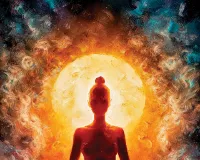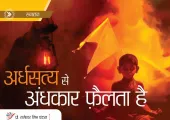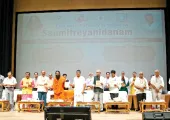Hindu, Hinduism, Nationality and Sanatan Dharma
On
Pro. Rameshwar Mishra Pankaj
The most important and distinctive word in the context of Hinduism is 'Dharma'. Even in the New Oxford English Dictionary, now the entry of the word 'Dharma' is different and its meaning has been given - 'The divine code of duty and self-religion according to Hindu and Buddhist 'Dharma'. While the entry of the word 'Religion' is different and its meaning is given- 'Belief (belief) in a single Supreme Deity'.
Hence the word 'religion' is specifically Hindu and Buddhist. It is well known that Lord Buddha himself was a Hindu and he used the word 'Dharma' in the Hindu sense only. Hence 'Dharma' is the special identity of Hindu. In this way only the Hindu religious scriptures have the right to determine what is religion. Just as Christianity is determined by the Bible and Islam is determined by the Quran. 'Dharma' is determined by the theological scriptures which are numerous and varied but there is consensus among all regarding 'Dharma'. This consensus is continuous from Rigveda to modern times. The 'Dharma' of the universe is in the form of a continuous cycle of universal cosmic laws, then the 'Dharma' of human beings is non-violence, truth, asteya, ritual, austerity, self-control, abstinence, holy life, peace and uprightness. This is the religion of human beings only, not of Hindus only. But it has been called human religion only in Hindu theology and thus it is the specialty of Hindu theology only. Therefore, faith in 'Dharma' is the identity of a Hindu. It is clear that 'Dharma' is eternal, has always been and will always be. Therefore, Hinduism is the eternal 'Dharma' faith. The word 'Hinduism' is an expression of the essence and meaning of being a Hindu according to grammar. One who has Hindutva, is a Hindu. One who does not have Hindutva cannot be a Hindu. It is impossible by definition. Hence Hindutva is the life and essence of Hindu, identity and conclusion.
After this consensus, according to the talent and expertise of the scholars and mystics in the religious scriptures, it is natural to elaborate on 'Dharma'. This is not a difference from the original, but it is an effort to explain the original. For example, in order to explain a poem or principle, its detailed discussion is done, but in any discussion, discussion is not absent. Similarly in the theology of 'religion'
There is a detailed discussion, but in any discussion, the basic form of 'religion' is not absent.
Necessity of religion for all human beings
Accordingly, common religion is that which is mandatory for all human beings in the whole world. This has also been called human religion, common religion, composite religion, universal religion and simple religion. The one who holds a human being in his natural healthy form is 'Dharma' (Manavdharma). That which obstructs and distracts, weakens and sickens the natural nature of man, is 'unrighteousness'. In this way, thinking of 'religion' for human beings is Hindutva and implementing that idea in life and continuously trying to implement it is the basic characteristic of being a Hindu.
Manu explained these in the form of ten symptoms. In Matsya Purana, Vayu Purana, Vishnu Purana and Markandeya Purana also these qualities have been told with little difference. Different memories also discuss these only. In the Mahabharata, Shantiparva says that the complete absence of malice towards all beings and the Panchamahabhutas and giving grace and charity to individuals and creatures is Sanatana Dharma. It is necessary to see that malice towards others is not expressed through gracious mind, words and deeds. This is the sign of great people.
Essential for life 'Dharma, Artha, Kama'
The religious scriptures have called 'Dharma', Artha and Kama Purusharth essential for life for humans. Every human being should wish for Moksha Purusharth, but not every person has the ability to do the spiritual practice of Moksha Purusharth. This power comes only after the accumulation of virtues of many births, it has been unanimously said in all the religious scriptures. The three purusharths that have been said for everyone, they are a part of 'religion' only when all three are religious. That is, righteous meaning and righteous work are the purusharth. Unrighteous work and meaning are perversion and sickness. Without going against 'Dharma', all possible happiness is attainable and enjoyable. The statement of Aap Stambha Dharmasutra is- 'Bhokta cha Dharmavirudhan Bhogan. And Mubhau Lokavbhijayati. The same thing has also been said in Udyogparv and Shantiparv. One should never indulge in lust by going against 'Dharma'. He commits sin. Hence 'Dharma' is the main criterion of Purusharth Trivarga.
The question of nationality is worth discussing in this context. In fact, it has been the ideal of all our scriptures that the Chakravarti Emperor should establish 'Dharma' on the whole earth. This is his right as well as his duty, but at the same time, from the scriptures and Puranas and historical texts it is proved from this that only very majestic emperors can establish 'Dharma' on the whole earth. It is a special Rajdharma. But in the geographical boundaries of India, 'Dharma' has got importance since time immemorial. Therefore, this geographical boundary determines nationality. Although this limit has also been decreasing according to the effort of the emperor. Because for thousands of years, the entire Eurasia has been the territory of the kings of India. It has been Rajdharma to ensure that Dharmachakra continues to operate in that entire region. However, the entire Himalayan region, which actually goes up to Siberia (Shimira) and includes the whole of North China and Russia and Afghanistan, Kazakhstan, Tajikistan, Turkmenistan, Azerbaijan, Khotan etc., starting from there to the oceans in the south-east and west, is part of India's territory. The national boundary has been fixed since ancient times. Among them, the region where the Aryans especially practice virtue is called Aryavarta.
India is the central area of Sanatana Dharma's practice
Aryavarta is the region extending from the Himalayan region to the Vindhya region and south of Kumari Cape. In whose south-east and west there is sea. This Aryavarta is a specially worthy area for Yagya. Where there are no Vedic Yagya, that area has been called Mlechha area. In this way, the nation of India is the central area for the practice of Sanatan 'Dharma'. According to the power, tenacity and efforts, it is the royal religion to continuously develop this area, but it is a mandatory duty to protect such a geographical area. This geographical area is the basis of nationality. Although it is also clear from the scriptures that wherever the people who follow Sanatan Dharma predominate, the spread of Indian nationalism should be considered there. In this way, there is no compulsion to be limited to the geographical area, but historically from the Himalayas to Indu Sarovar i.e. Indian Ocean and Indus Ocean, especially the national territory of India. Along with following general religions here, the residents here have been following their own specific 'Dharma' i.e. Swadharma. This self-religion is possible only when there is a strong state. Where there is no strong state, that area becomes chaotic. The condition of an anarchic district is appalling. This thing has been said time and again in Ramayana, Mahabharata and all the Puranas. Therefore, to ensure the observance of Sanatan 'Dharma' in the entire nation, it is necessary to have a national state. This feeling is the basis of nationalism.
That is why Rajdharma has been called the essence of all religions. In Mahabharata it is said in Shantiparva.
'Sarva Dharma Rajdharmapradhanah l Sarva Varnah Palyamana Bhawanti ll
Sarvastyago Rajdharmeshu Rajan l Tyagam Dharmam Chahuragyaram Puranam ll Majjet Triyi Dandnitau Hatayam I Sarve Dharmah Prakshyeyurvibuddhah l
Sarve Dharmashchashramanam Hatah Syuh I Kshatre Tyakte Rajdharme Purane ll
Sarve Tyage Rajdharmeshu Drishtah I Sarva Diksha Rajdharmeshu Choktah l
Sarva Vidya Rajdharmeshu Yuktah I Sarve Loka Rajdharme Pravishtah ll
(Rajdharma is the most important religion because only under the protection of Rajdharma, all varna religions can be followed. That's why following Rajdharma is the supreme sacrifice of the emperor. This is what the sages have said. If punishment will be destroyed, then neither will the Vedas. There will be no prestige, nor will religion be followed and flourished in the society. Due to the extinction of Rajdharma, all the religions of Varnas and Ashrams disappear. Therefore, the initiation of Rajdharma is the best initiation. The education that gives knowledge of Rajdharma is the best of all education. is sheltered and all the worlds are protected by Rajdharma only.)
Indra and Mandhata Dialogue
In the 65th chapter of Shantiparva, there is mention of the dialogue between Indra and Mandhata in ancient times, in which Mandhata has been told by Indra that the Yavanas, the Kiratas, the Gandharas, the people of China, the Shabarjans, the Barbarjans, the Shakas, the Tusharas, the Kankas, the Pahnavas, the Andhras, The Sanatan Dharma of all Brahmins, Kshatriyas, Vaishyas and artisans, including Mandrakas, Paundras, Pulindas and Kamboja residents, is service and grooming of parents, Acharyas and scholars, and grooming of sages living in ashrams (listening to them carefully is the only grooming ), respect towards kings, rituals of Vedic deeds and religion, Shradh of ancestors, digging wells, vapi, tadag etc., running water area means making water accessible to people in public. Giving charity, building dharamshalas, truthful speech, non-violence, behaving without anger, protecting the livelihood of others, protecting one's ancestral property, maintaining one's wife and children, leading a pious life and not harboring ill-will towards anyone. All this is the religion of human beings. It is the duty of the king to see that these religions are followed uninterruptedly. It is Rajdharma to punish those who create obstacles in this. When the rulers do not follow Rajdharma, then all the living beings lose the discretion of duty and non-duty.
In this way only the state which follows Rajdharma protects the nationality. Suppression of the hindering elements of nationalism is the only purification. Kantakshodhan is the main Rajdharma. In the protection of nationalism, efficient punishment of the state is paramount. Along with this, it is Rajdharma to see that in a safe state, discussion of scriptures and religion should be uninterrupted and religious traditions should be followed uninterruptedly. In the absence of Rajdharma, nationalism is divided and Sanatan Dharma is interrupted.
Tags: patanjali patanjali wellness yog sandesh education india bharat university of patanjali bharat swabhiman patanjali yog samiti swami ramdev ji maharaj patanjali gurukulam acharyakulam patanjali research institute Acharya balkrishna patanjali yogpeeth patanjali yog sandfdesh yog gram yog guru haridwar devbhumi mahila patanjali yog samiti patanjali ayurvedic hospital Hindu Hinduism Nationality and Sanatan Dharma
लेखक
Related Posts
Latest News
01 Oct 2024 17:59:47
ओ३म 1. सनातन की शक्ति - वेद धर्म, ऋषिधर्म, योग धर्म या यूं कहें कि सनातन धर्म के शाश्वत, वैज्ञानिक,...





.jpg)



.jpg)









.jpg)
.jpg)
